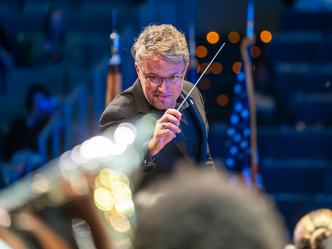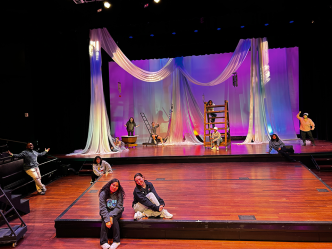It’s that time of the year again when some people will argue about the meaning of Christmas, others will be guilted into gift-giving and some will claim commercialization has ruined the holiday altogether.
But then there’s Dr. Ruth McClelland-Nugent, a pop culture scholar, who says the root of these external and internal conflicts actually lies in the creation of our modern celebration of Christmas.
“It’s ironic that today we talk about Christmas being too commercial,” said McClelland-Nugent, associate professor of history in the Katherine Reese Pamplin College of Arts, Humanities, and Social Sciences at Augusta University. “In the U.S., it really became popular through this commercial process. The popularization of Christmas in the United States begins with advertising.”
The first turning point
McClelland-Nugent points to two periods in American history that were turning points in creating the Christmas celebration we know today.
The first period was the 1840s, when Christmas entered the Northeast, and its big cultural centers like New York and Boston, as a commercially tied holiday aimed at children.
Before then, Christmas was not widely celebrated in America. The Puritans who settled in New England in the 1600s had even made it illegal to celebrate the holiday.
“In the 17th and 18th centuries, for many English-speaking people who celebrated Christmas, it was a time to get drunk,” McClelland-Nugent said. “If there were any gifts given, that was on New Year’s Day.”
But German immigrants and imports introduced the idea of Christmas as a child-centered holiday and a time to give gifts to others.
“Making it this children-centered Christmas with presents is of course a great marketing opportunity,” McClelland-Nugent said.
The Germans and the Catholic Dutch also introduced Americans to the image of St. Nicholas, the patron saint for the poor, children and bakers. St. Nicholas was known for going into people’s homes on his day, Dec. 6, to leave presents for children in stockings.
Around the same time, the English notion of Father Christmas was reaching a broader American audience, mainly through Charles Dickens’ A Christmas Carol.
“The Ghost of Christmas Present, a very jolly one with the big green robe, is kind of what Father Christmas was like in the 19th century,” McClelland-Nugent said.
Marketers in New York saw the personification of Christmas as an opportunity to sell goods and began to associate this early image of Santa Claus with their advertisements in the 1840s.
“Capitalism helps take these sort of European traditions from two different places — the German tradition and the English tradition — and meld them into something new,” McClelland-Nugent said.
Turning something new into something popular
This new idea of a child-centered, gift-giving holiday was most prevalent in the Northeast and was not largely adopted in the South through the early 1900s, when mass advertising and mass production changed Christmas forever.
“We get the first mass advertising in the 1920s and ’30s with professionals who are using some of the new psychological theories about advertising to drive these very sophisticated campaigns,” McClelland-Nugent said. “They were marketing a Christmas experience in which your children will love you and your family will be happy together. All you need to do is buy their stuff.”
In this second period, marketers worked to standardize Christmas and make the celebration popular.
They created mass advertising campaigns on radio to promote a standardized version of Christmas. Their brand-related jingles interrupted programming, and they even sponsored entire programs.
Between the 1930s and 1950s, pop-culture songs like White Christmas by Bing Crosby, Santa Claus Is Comin’ to Town by Fred Coots and Haven Gillespie, and Happy Holiday by Irving Berlin also helped sell the idea of what the ideal Christmas should look like.
Stores in major cities across the United States reinforced this standardized image of Christmas by using massive holiday displays to create mood.
“These were very artistic,” McClelland-Nugent said. “All that commercialism drives people to say, ‘What do Christmas decorations look like? What does Santa Claus look like? What do nicely wrapped presents look like?’ That explodes in the post-World War II period, when people finally have money to spend and commercial goods to buy.”
Stores also began to send out shopping catalogs with images of Santa Claus to entice customers into shopping their distant, mass-produced goods.
Macy’s New York department store also helped develop the image of Christmas as a business opportunity when it organized its first Thanksgiving Day Parade in 1924, McClelland-Nugent said. The parade has traditionally launched the holiday shopping season.
“One of the classic images for Americans of Santa Claus comes from the parade,” she said. “It’s a commercial image.”
The modern image of Santa Claus, however, came from Coca-Cola advertising campaigns from the 1930s.
“Santa is no longer wearing robes,” McClelland-Nugent said. “Coca-Cola gives us the modernized Santa, still jolly and fat, but with this sort of red suit and the standardized boots. From there we get the 20th-century image.”
This cross-marketing strategy to reach a mass audience always carried the same message: Santa Claus is going to bring gifts to the children.
“The pressure is on parents to buy gifts for their children,” McClelland-Nugent said. “The feeling of guilt is absolutely intentional. If you don’t buy it, your children won’t have that. And who would want that? You want to be a good parent.”
In the post-World-War-II period, children became targets of advertisers for the first time ever.
“The image of the American family is at the center of the culture in which the baby boomers are children,” McClelland-Nugent said. “The baby-boom generation is so large that advertisers figured out they could market things directly to children.”
A secular Christmas
The elements of this commercial version of Christmas that advertisers created was largely secular.
“Those elements don’t have to be tied to Christianity,” McClelland-Nugent said. “Those big store displays don’t generally include a lot of images of Jesus. The commercial aspects that we are selling — the Santa, the trees — are not closely tied to a particular theology of Christmas.”
The secularization of Christmas was also intentional, she said. The idea was to create a holiday season that all Americans, Christians and non-Christians, could experience. By sharing the joy, they would also spend more money.
Saying “Happy Holidays” helped accomplish that.
“‘Happy Holidays’ allows you to observe Hanukkah, for example, which in the Jewish religious calendar is actually not that important a feast,” McClelland-Nugent said. “But for mid-century advertisers, it becomes the equivalent to Christmas because it also involves gifts and children. And you can market to Jewish parents and make them feel guilty.”
The secularization and commercialization of Christmas, McClelland-Nugent said, are nothing new.
“We have this history in our heads that the holidays were always one way until maybe 20 or 30 years ago, and everyone ruined it then,” she said. “But in fact Christmas has bits and pieces that come at different times and from different places. And so it keeps changing, and it’s still changing. I don’t know what Christmas is going to look like in 20 or 30 years.”
For that reason, she says people shouldn’t be concerned when others fight over the meaning of Christmas.
“Those are continuing discussions,” she said. “We shouldn’t panic too much when people are arguing about what Christmas means or what it is or isn’t.”
 Augusta University
Augusta University




